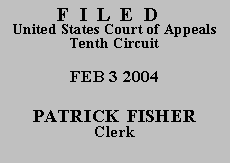

| UNITED STATES OF AMERICA, |
|
| v. | |
| RUBEN GARCIA HERNANDEZ, |
Defendant's indictment and presentence report listed the following convictions for violent felonies: burglary, on February 2, 1968; sexual penetration and false imprisonment, on September 30, 1977; aggravated assault, on September 28, 1985; and escape from jail, on December 15, 1985. See 18 U.S.C. § 924(e)(2)(B) (defining "violent felony" as "any crime punishable by imprisonment for a term exceeding one year . . . that--(i) has as an element the use, attempted use, or threatened use of physical force against the person of another; or (ii) is burglary or . . . otherwise involves conduct that presents a serious potential risk of physical injury to another"); United States v. Moudy, 132 F.3d 618, 620 (10th Cir. 1998) (holding that a felony escape, violent or not, is necessarily a "violent felony" for the purposes of § 924(e), given the threat of injury it poses to others). Besides finding that § 924(e) applied, the district court also determined that Defendant was an armed career criminal under § 4B1.4 of the United States Sentencing Guidelines, which designates a person subject to an enhanced sentence under § 924(e) as an "armed career criminal."
Defendant directed defense counsel to file a notice of appeal on his behalf, on the ground that the district court incorrectly determined that he was a career criminal under U.S.S.G. § 4B1.1. Specifically, Defendant contends that the district court should not have counted his prior convictions for (i) criminal sexual penetration, because he had served his time for that conviction and completed a post-incarceration probation; and (ii) escaping from jail, because that should not count as a violent felony.
Defense counsel has filed an Anders brief indicating his belief that the case affords no non-frivolous issues for appeal. See Anders v. California, 386 U.S. 738, 744 (1967). Although Anders entitles the defendant to raise additional points in response to counsel's Anders brief, Defendant has made no such filing.
Agreeing with counsel that Defendant's claims are frivolous, we GRANT counsel's request to withdraw and DISMISS the appeal.
ENTERED FOR THE COURT
Harris L Hartz
Circuit Judge
*.After examining the briefs and appellate record, this panel has determined unanimously that oral argument would not materially assist the determination of this appeal. See Fed. R. App. P. 34(a)(2); 10th Cir. R. 34.1(G). The case is therefore ordered submitted without oral argument. This order and judgment is not binding precedent, except under the doctrines of law of the case, res judicata, and collateral estoppel. The court generally disfavors the citation of orders and judgments; nevertheless, an order and judgment may be cited under the terms and conditions of 10th Cir. R. 36.3.